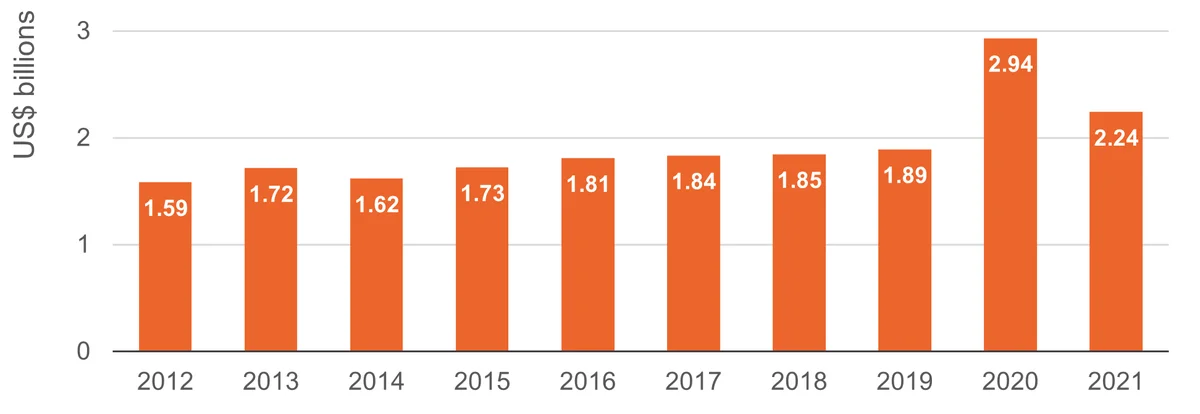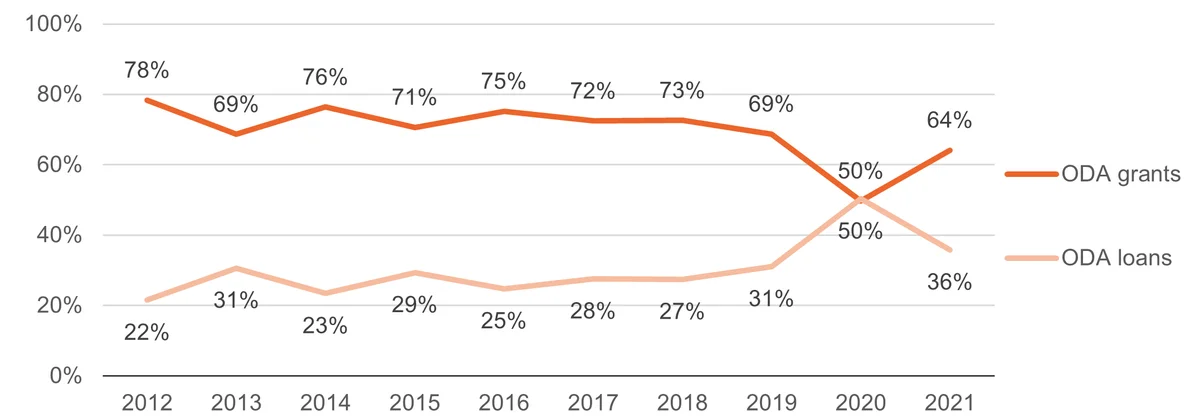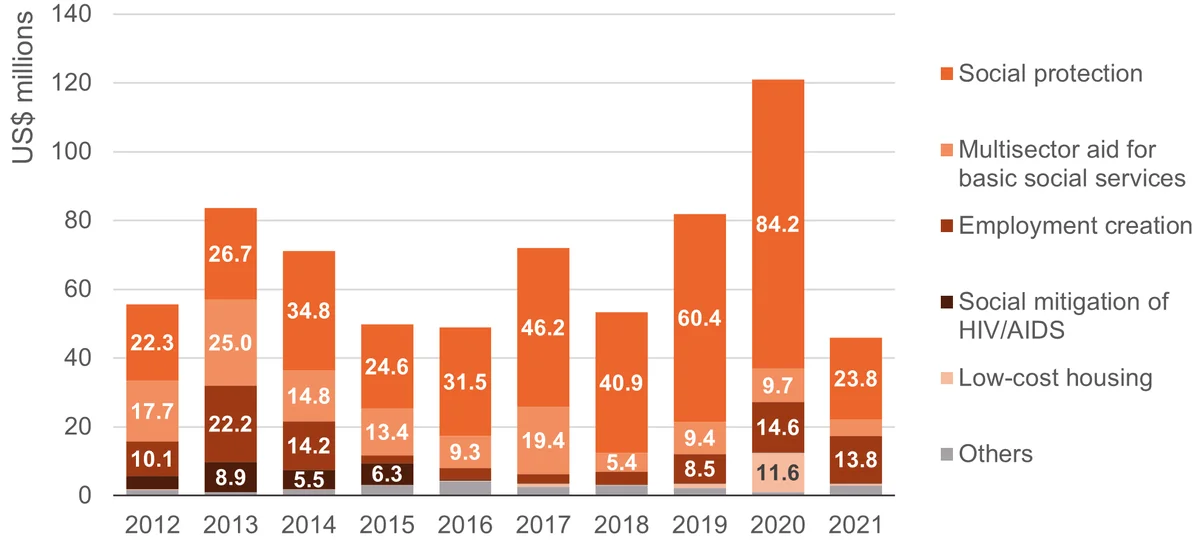Aid effectiveness in Uganda: Social protection in focus
This report analyses ODA's role in delivering social protection in Uganda. It examines the success of an aid-recipient programme and presents lessons for donors.
DownloadsOverview
Recent challenges, including the Covid-19 pandemic and conflicts around the world, have negatively impacted Uganda’s domestic revenue collection, and changed donor countries’ aid policies, widening Uganda’s budget deficit. Moreover, official development assistance (ODA) now faces enormous pressures from growing, competing demands, including humanitarian and crisis response, national development priorities and investment in global public goods. Development Initiatives (DI) seeks to highlight the value of ODA in programmes that are national priorities to recipient countries. Additionally, DI aims to enhance the understanding of enabling factors that contribute to improving aid impact.
Led by national demand for international finance data and evidence on its most appropriate use, DI embarked on producing a series of country case study reports to consider how aid has been effective in specific development sectors in Kenya , Ethiopia and Uganda, including trends, the factors that unlock the value of aid, and the challenges that lie ahead.
This country report for Uganda provides evidence on the role and contribution ODA in the delivery of social assistance programmes. It first provides a background and overview of ODA disbursements to Uganda – both generally and specifically to the social protection sector. Then, drawing on secondary data obtained from various impact evaluation studies and key informant interviews, the report highlights how ODA and other factors have enabled the establishment and implementation of Uganda’s flagship Expanding Social Protection (ESP) programme.
You can read this overview and the executive summary below, or download the full report .
The report finds that between 2012 and 2021, just 2% of ODA disbursed to Uganda went to the social protection sector. Total ODA to social protection in Uganda has grown rapidly: in 2015, with the onset of the implementation of the second phase of the ESP programme, it reached US$24.6 million; by 2020 it had peaked at US$84.2 million due to an increase in disbursements to support the government’s response to the Covid-19 pandemic. The growth in ODA disbursements to social protection from 2015 to 2021 was coupled with increasing government commitment to financing the expansion of social protection and increasing coverage of the ESP programme, from the initial 15 pilot districts to the entire country. Disbursements sharply declined to US$23.8 in 2021 as funding for ESP ended.
Our review of impact evaluation reports shows that ODA played a significant catalytic role in the development of critical social protection systems and structures in Uganda. This paved way for the eventual rollout and expansion of the ESP programmes studied. The ESP programme improved the welfare of beneficiary households who were able to use cash transfers to invest in productive assets, education and health. Factors beyond ODA that enabled this success include government ownership and commitment, alignment of donor priorities to government development aims, and multistakeholder partnerships. Read our executive summary for more detailed findings and lessons for the effective investment of ODA in social assistance programmes and other donor funded initiatives.
► Read more about our work in Uganda
► Share your thoughts with us on Twitter or LinkedIn
► Sign up to our newsletter
Box
Important note about the aid data used in this report
This report uses aid data from the OECD DAC which is complete and verified and thus presents an important and detailed picture of trends. OECD DAC data is, however, published at least a year in arrears, meaning that the latest detailed data available is up to 2021. The analysis therefore covers the period between 2012 and 2021 and uses gross disbursements.
In this report, the term ‘aid’ encompasses development assistance but excludes all humanitarian aid. Aid here includes ODA (as defined by the OECD DAC) and equity investments reported by official actors to the OECD.
Executive summary
Due to Uganda’s limited capacity to mobilise domestic resources, the country has needed to rely on official development assistance (ODA). Recent challenges, including the Covid-19 pandemic and Russia’s war in Ukraine, have negatively impacted domestic revenue collection and changed donor countries’ aid policies, widening Uganda’s budget deficit.
This report presents key trends in ODA between 2012 and 2021 and assesses its effectiveness in Uganda using a case study on ODA financing for the Expanding Social Protection (ESP programme). The ESP targets social protection to people experiencing the most extreme poverty. It started in 2010, with the aim of putting in place a national social protection system aligned with Uganda’s National Social Protection Policy (NSPP). The programme started with donor support for the implementation of a pilot phase of the senior citizens grant in 15 districts that ran until 2015 (phase one). During phase two of the programme (2015 to 2021), the coverage was subsequently scaled up to cover the entire country following the government’s 2018 decision to roll out the grants to all districts. ESP is now rolled out as a key pillar of the social protection approach in Uganda.
As well as key findings, we provide lessons and recommendations for improving the effectiveness of ODA, especially government and donor staff who plan and fund programmes.
Key findings
Key finding 1: Total ODA to Uganda grew marginally from 2012 to 2021, except for a sharp rise in 2020 due to the Covid-19 response
ODA disbursements to Uganda marginally grew from US$1.6 billion in 2013, peaking at US$2.9 billion in 2020 before falling sharply to US$2.2 billion in 2021.
ODA disbursements to Uganda (constant figures in US$ billions), 2012–2021

placeholder
Source: Development Initiatives based on data from OECD DAC.
Key finding 2: Uganda has seen an overall decline in the share of grants as a proportion of ODA disbursements
ODA concessional loans and grants (% of total disbursement), 2012–2021

placeholder
Source: Development Initiatives based data from OECD-DAC.
Notes: The increase in ODA grants in 2021 is attributed to the Covid-19 response. Equity investments accounted for 1.4% of total ODA disbursements from 2012 to 2021 (0.1% in 2012, 0.8% in 2013, 0.2% in 2014 and 0.3% in 2019).
The overall growth in ODA from 2012 to 2021 was driven by the increasing share of concessional loans. Grants remain predominant but declined as an overall proportion of ODA over the same period. On average, the year-to-year growth in loans was 20% compared to 2% for grants.
Key finding 3: ODA disbursements to social protection accounted for much of the allocations under the ‘other social infrastructure’ sector between 2012 and 2021
At 2%, the share of ODA to social protection in Uganda is higher compared to another recipient country like Kenya (1.3%) for the same period. ODA for social protection has been instrumental in building capacity, providing technical assistance and financing the implementing social protection programmes. This funding has supported the Expanding Social Protection (ESP) programme, as well as the Northern Uganda Social Action Fund (NUSAF) and the Development Response to Displacement Impacts Project (DRDIP), all of which are now key pillars for social protection in Uganda.
ODA disbursements for social infrastructure (constant figures in US$ millions), 2012–2021

placeholder
Source: Development Initiatives based on data from OECD-DAC.
Notes: ‘Others’ includes culture and recreation, housing policy and administrative management, labour rights, social dialogue, and statistical capacity building activities and services.
Key finding 4: ODA has played a significant role in building and shaping Uganda’s current social protection systems.
The pilot for the national ESP programme was 100% ODA funded, showcasing the impact of donors on social protection in Uganda. Some successes of the pilot programme included the completion and launch of Uganda’s NSPP, the expanded coverage of direct cash transfers to more people facing vulnerability, and the scale-up of the direct cash transfer programme to all districts in Uganda.
Notable elements and success factors in implementing the ESP programme include:
- Alignment with government plans: Donor engagement and partnership with government from the outset ensured that the programme was issue driven: designed to address existing needs and gaps. This also helped in putting the programme on a clear sustainability path, including a transition away from donor funding.
- Coordination and governance: The ESP stands out as a best-practice example of good coordination and implementation of donor-funded activities. Coordination between government and donors, and partnerships with civil society organisations (CSOs), have been evident in the implementation of the programme. The government has spearheaded the conceptualisation and implementation of social protection activities under the ESP, determining activities and their targeting.
- Learning for impact: Monitoring, evaluation and learning have been core components of the ESP. The lessons and experience from the pilot phase were critical for the development and implementation of the subsequent phases of the programme. Donors were able to show impact and evidence the case for how investment in social protection could contribute to Uganda’s development aspirations. It was easier to promote the programme to the Government of Uganda and other development partners after proving that it works.
- Developing capacity for aid fund management: Following the successful pilot, there was sustained funding and technical support for the scale-up in the second phase of the ESP programme, which ran from 2015 to 2021. While two of the funders that supported the pilot and second phase of the programme (the UK’s Department for International Development (DFID) [1] and Irish Aid) exited at the end of ESP II in 2021, [2] the World Food Programme and UNICEF were still offering technical support at the time of writing.
Key finding 5: Sustainability remains an outstanding challenge.
While a few donors continue to support the ESP programme, low funding for social protection remains a major challenge for the government. This has limited the depth of coverage under the current phase of the programme in which the government has belatedly (in 2021) started to roll out coverage to the entire country. Only 20% of eligible beneficiaries have been actively reached so far.
Lessons and recommendations for donors
There are several important lessons about aid effectiveness to be drawn from the case study. These could maximise the impact of aid in heavily donor-funded development programmes.
- Learning and adaptation are crucial for success: These were key to implementing the donor-funded phase of the ESP programme, demonstrating that a learning agenda must be at the forefront. Moreover, learning needs to be applied continuously and implemented holistically, taking into consideration the dynamic context in which development happens.
- Country buy-in and ownership is critical for success and impact: It is important that donors learn to work with and not against or alongside recipient governments in the delivery of aid and implementation of donor-funded programmes. This case study revealed that having government taking a lead role in the conceptualisation of projects, based on its understanding of underlying problems and need, is an important and necessary first step in the implementation of donor-aided programmes. Moreover, alignment with existing policies and structures in recipient countries (even when the donor’s development agency is playing a lead role in implementing donor-funded activities) is important.
- Flexibility in funding disbursements is needed to accommodate changes and adaptation: This chimes with a learning-oriented implementation of ODA-financed programmes. The ESP was among the many donor-funded programmes affected by the Covid-19 pandemic, leading to delays in implementation. Donors should leave room for adjustments in already-costed project workplans and strategies to accommodate unforeseen risks and challenges.
- Partnership and collaboration with key stakeholders is crucial: Starting by identifying the key stakeholders and involving the right partners and technical teams from the outset increases ownership and the potential for positive impact. Such partnerships require donors to have clear communication and coordination tools and a platform that attracts partners to share and combine ideas and resources to identify and solve challenges. Donors should consider, incorporate and track all partners’ interests, priorities and resources. They can achieve this by ensuring the right people are involved in designing and implementing projects.
- A harmonised approach built on a thorough understanding of the financing landscape using near-real time data is helpful: This can minimise aid fragmentation and duplication and maximise synergies and improve mechanisms for aid effectiveness. It will also help donors to learn from, adapt to and work within existing government structures, improving the efficient and effective delivery of aid-funded programmes.
- Building local technical capacity for implementing donor-funded projects is important: This by can be achieved by working directly with local partners, especially the recipient government, in ensuring funded activities align with national development priorities and that the government is in position to continue implementation when donors exit. This case study showed that donors can significantly improve government’s technical capacities for implementing donor-funded programmes, monitoring development finance impact and effectiveness, and ensuring sustainability.
Notes
-
1
The UK’s Department for International Development (DFID) closed in 2020. It was replaced by the Foreign, Commonwealth & Development Office.Return to source text
-
2
FCDO, Policy paper. UK-Uganda development partnership summary, July 2023. Available at: https://www.gov.uk/government/publications/uk-uganda-development-partnership-summary/uk-uganda-development-partnership-summary-july-2023 . Accessed. 14 May 2024.Return to source text
Related content
Gender-focused ODA to health and agriculture in Ethiopia
This report looks at the use of ODA in programmes with a gender focus in the health and agriculture sectors in Ethiopia, and how an enabling environment can be fostered for development outcomes.
The role of ODA in delivering social protection in Kenya
This report provides background on the role of ODA in delivering social assistance in Kenya. Using three case study programmes, it examines aid disbursement trends, programme impacts and key lessons.
Improving the impact of ODA on social protection in Kenya
This briefing explores the role of ODA in delivering social protection programmes in Kenya. We explore three case study programmes, and examine their successes, challenges and financing opportunities.